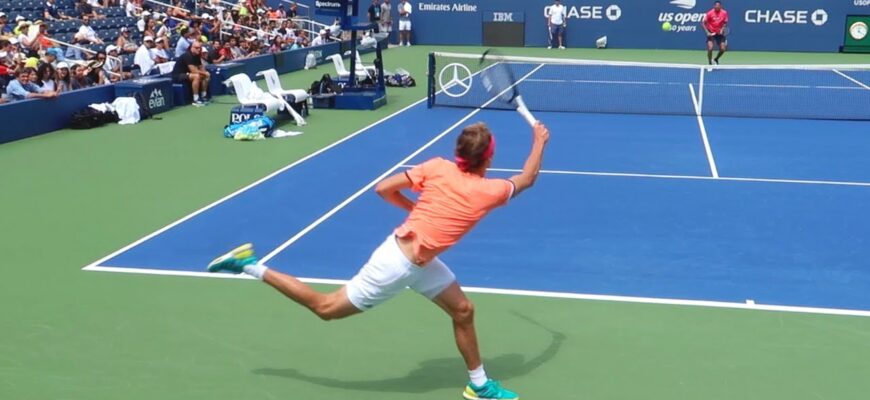In the world of professional tennis, debates often swirl around everything from umpiring calls to player etiquette. Yet, a more subtle, but equally fervent, discussion periodically surfaces concerning the very ground upon which these battles are fought: the speed of the courts. Recently, German star Alexander Zverev reignited this conversation with pointed remarks about what he perceives as a homogenization and slowing down of surfaces, a trend he suggests may unfairly benefit certain top-tier players.
Zverev`s Strategic Serve: Accusations of Standardization
The third-ranked player in the world, Zverev, did not mince words. His criticism, notably voiced during the Shanghai Masters, posited that tournament organizers are increasingly opting for standardized court speeds. And not just any speed, but a *slower* one. According to Zverev, this shift creates an environment where baseline grinders and players capable of extending rallies – think Carlos Alcaraz and Jannik Sinner – gain a distinct, engineered advantage.
“They are standardizing courts and slowing them down,” Zverev claimed, suggesting a deliberate strategic choice by tournaments rather than a natural evolution.
It`s a bold assertion, implying a calculated move that goes beyond simply providing a fair playing field. For a player who relies on powerful serves and aggressive play, a slower surface can neutralize some of their greatest weapons, turning quick-strike points into drawn-out affairs that might favor opponents with superior endurance or rally craft.
Cincinnati`s Swift Rebuttal: A Director`s Defense
Responding to these allegations, Bob Moran, the Director of the Cincinnati Masters, offered a rather unambiguous denial, as one might expect from an event director whose tournament was indirectly referenced in the broader discussion of “standardization.” Moran`s stance was clear: the aim is not to manipulate conditions to aid individual players. Indeed, he emphasized that Cincinnati`s courts have historically been recognized for their quickness.
“We never try to create conditions that would help individual players – we haven`t even thought about it,” Moran stated, addressing the core of Zverev`s insinuation.
Moran further elaborated on Cincinnati`s specific approach, highlighting a commitment to consistency across the critical American hard-court series, which stretches from Washington through to the US Open. Their objective, he explained, is a “stable speed (from medium-fast to fast) and stable balls.” This, he asserted, is precisely what players themselves have requested. The irony, perhaps, is that in a sport striving for uniformity, even the pursuit of consistency can be perceived as a form of bias.
The Unseen Battle: Why Court Speed Matters
Beyond the immediate exchange between Zverev and Moran lies a deeper, ongoing debate about the very character of professional tennis. Court speed is not merely a technical specification; it profoundly influences:
- Player Strategy: Faster courts reward big serves, quick points, and aggressive net play. Slower courts favor extended rallies, defensive skills, and strategic placement.
- Player Archetypes: Certain players thrive on specific surfaces. Historically, serve-and-volley specialists dominated grass, while clay favored baseliners. As surfaces become more uniform, so too might the `ideal` player profile.
- Match Dynamics: Slower courts often lead to longer rallies, potentially increasing spectator engagement (more shots per point) but sometimes at the cost of varied play styles.
- Injury Risk: The impact forces on a player`s body can vary significantly between very fast and very slow courts, though consistency is often cited as a measure to reduce unexpected stresses.
The argument for “standardization” from a tournament perspective often hinges on fairness and predictability. Players, especially those competing week-in, week-out across different events, benefit from knowing what to expect from the surface. It allows for consistent preparation and reduces the element of surprise that can lead to early exits or even injuries.
The Great Homogenization: A Broader Trend?
Zverev`s comments tap into a long-standing observation within tennis: the perceived “homogenization” of surfaces over the last few decades. The once stark differences between grass (Wimbledon), clay (Roland Garros), and hard courts have arguably blurred. Even within the hard-court swing, variations in speed and bounce used to be more pronounced. This trend has often been attributed to a desire for longer rallies (more TV time, more drama) and to appeal to a broader base of players who might not specialize in one extreme surface.
If courts are indeed being subtly slowed, it raises questions about whether the sport is unintentionally (or intentionally) favoring a particular style of play. While Alcaraz and Sinner are phenomenal talents capable of excelling anywhere, their relentless baseline power and stamina are undeniably potent weapons on courts that allow for an extra shot or two in a rally.
Conclusion: A Debate That Serves On
The “court speed” debate, while seemingly niche, underscores the intricate balance between competitive fairness, player preference, and tournament objectives. Is Zverev merely grumbling about conditions that don`t perfectly suit his game, or is he highlighting a legitimate shift in the sport`s infrastructure that could reshape its future? Tournament directors like Moran maintain they are listening to the players and striving for consistency, not favoritism.
Ultimately, the discussion around court speed is a testament to the fine margins at the elite level of tennis. Every bounce, every fraction of a second, can be the difference between victory and defeat. And as long as players wield rackets and tournaments lay down courts, this silent battle for optimal conditions will continue to serve up controversy, even if the ball speed itself remains, steadfastly, medium-fast to fast.








